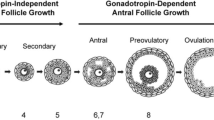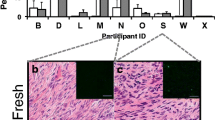Abstract
The development of an in vitro culture system, comparable to the in vivo environment in terms of effects on oocyte growth and development, could provide a valuable experimental tool for studying the mechanisms governing oocyte development as well as practical clinical, agricultural, zoological, and biotechnological applications. This study reports on the importance of the microenvironment for the ovarian folliculogenesis process. The complexity of such a microenvironment was approached with a strategy based on functionalized PEG-hydrogels. The PEG matrix not only serves as a scaffold, but it is also used a reservoir of immobilized cues. Using tethered integrin-binding peptides in combination with other signaling factors, we aimed at better understanding the interactions of the oocyte and its surrounding granulosa that may determine the efficiency of the actual and the future in vitro mature oocyte production. In a first step, the mechanical properties of PEG-hydrogel were optimized for producing secondary follicles, in which the oocyte is surrounded by two layers of granulosa cells. Follicle growth was highly dependent on the mechanical properties of the surrounding environment, with the optimal elastic modulus being approx. 1 kPa. The effects of key soluble factors were also investigated to confirm their compatibility with the established 3-D culture system and to further qualitatively and quantitatively improve the produced mature oocytes. Accordingly, various combinations of the gonadotropins follicle-stimulating hormone (FSH) and luteinizing hormone (LH) were tested. Interestingly, the effects of the gonadotropins in the 3-D PEG system were close to their known in vivo effects. In conclusion, this study demonstrates the efficiency and the flexibility of a novel 3-D culture system, PEG-hydrogel. Circumventing problems inherent to the “on-plastic” standard culture, such as the loss of the granulosa-oocyte interactions, allowed the emergence of a culture system tailored for investigating fundamental folliculogenesis-related questions. Furthermore, the reported culture system may serve as a platform for developing clinical and biotechnology applications.

Similar content being viewed by others
References
J. Godwin, D. Kuraitis, and N. Rosenthal, Int. J. Biochem. Cell Biol., 56C, 47 (2014).
R. J. Rodgers, H. F. Irving-Rodgers, and I. L. van Wezel, Mol. Cell. Endocrinol., 163, 73 (2000).
H. F. Irving-Rodgers and R. J. Rodgers, Cell Tissue Res., 322, 89 (2005).
M. F. Smith, W. A. Ricke, L. J. Bakke, M. P. D. Dow, and G. W. Smith, Mol. Cell. Endocrinol., 191, 45 (2002).
E. E. Telfer and M. B. Zelinski, Fertil. Steril., 99, 1523 (2013).
T. Miyano, J. Reprod. Dev., 51, 169 (2005).
K. Liu, P. Wahlberg, G. Leonardsson, A. C. Hagglund, A. Ny, I. Boden, C. Wibom, L. R. Lund, and T. Ny, Dev. Biol., 295, 615 (2006).
A. C. Hagglund, A. Ny, G. Leonardsson, and T. Ny, Endocrinology, 140, 4351 (1999).
B. Goxe, J. E. Flechon, S. Delasalle, and R. Salesse, Biol. Cell, 83, 169 (1995).
J. J. Eppig, M. OBrien, and K. Wigglesworth, Mol. Reprod. Dev., 44, 260 (1996).
A. J. W. Hsueh, H. Billig, and A. Tsafriri, Endocr. Rev., 15, 707 (1994).
M. H. Abel, A. N. Wootton, V. Wilkins, I. Huhtaniemi, P. G. Knight, and H. M. Charlton, Endocrinology, 141, 1795 (2000).
A. P. Almeida, D. M. Magalhaes-Padilha, V. R. Araujo, S. L. Costa, R. N. Chaves, C. A. Lopes, M. A. Donato, C. A. Peixoto, C. C. Campello, J. B. Junior, and J. R. Figueiredo, Anim. Reprod. Sci., 152, 32 (2015).
I. Adriaens, R. Cortvrindt, and J. Smitz, Hum. Reprod., 19, 398 (2004).
R. J. Urban, J. C. Garmey, M. A. Shupnik, and J. D. Veldhuis, Endocrinology, 128, 2000 (1991).
J. M. Silva, M. Hamel, M. Sahmil, and C. A. Price, Reproduction, 132, 909 (2006).
I. Demeestere, J. Centner, C. Gervy, Y. Englert, and A. Delbaere, Reproduction, 130, 147 (2005).
M. J. O'Brien, J. K. Pendola, and J. J. Eppig, Biol. Reprod., 68, 1682 (2003).
P. L. Nayudu and S. M. Osborn, J. Reprod. Fertil., 95, 349 (1992).
J. D. Mao, G. M. Wu, M. F. Smith, T. C. McCauley, T. C. Cantley, R. S. Prather, B. A. Didion, and B. N. Day, Biol. Reprod., 67, 1197 (2002).
R. Cortvrindt, J. Smitz, and A. C. VanSteirteghem, Hum. Reprod., 12, 759 (1997).
L. M. Mitchell, C. R. Kennedy, and G. M. Hartshorne, Hum. Reprod., 17, 1181 (2002).
A. B. Galway, P. S. Lapolt, A. Tsafriri, C. M. Dargan, I. Boime, and A. J. W. Hsueh, Endocrinology, 127, 3023 (1990).
R. Cortvrindt, Y. Hu, and J. Smitz, Hum. Reprod., 13, 1292 (1998).
S. T. Lee, M. H. Choi, E. J. Lee, S. P. Gong, M. Jang, S. H. Park, H. Jee, D. Y. Kim, J. Y. Han, and J. M. Lim, Fertil. Steril., 19, 1193 (2007).
S. A. Pangas, H. Saudye, L. D. Shea, and T. K. Woodruff, Tissue Eng., 9, 1013 (2003).
M. P. Lutolf and J. A. Hubbell, Biomacromolecules, 4, 713 (2003).
T. P. Kraehenbuehl, P. Zammaretti, A. J. Van der Vlies, R. G. Schoenmakers, M. P. Lutolf, M. E. Jaconi, and J. A. Hubbell, Biomaterials, 29, 2757 (2008).
U. Eichenlaubritter and I. Betzendahl, Mutagenesis, 10, 477 (1995).
J. Liu, A. Rybouchkin, J. Van der Elst, and M. Dhont, Biol. Reprod., 67, 575 (2002).
R. Cortvrindt and J. Smitz, Reprod. Domest. Anim., 36, 3 (2001).
S. Senbon, Y. Hirao, and T. Miyano, J. Reprod. Dev., 49, 259 (2003).
J. J. Eppig, J. Exp. Zool., 198, 375 (1976).
D. T. Heller, D. M. Cahill, and R. M. Schultz, Dev. Biol., 84, 455 (1981).
E. Anderson and D. F. Albertini, J. Cell Biol., 71, 680 (1976).
R. K. Assoian and E. A. Klein, Trends Cell Biol., 18, 347 (2008).
F. Brandl, F. Sommer, and A. Goepferich, Biomaterials, 28, 134 (2007).
M. Xu, E. West, L. D. Shea, and T. K. Woodruff, Biol. Reprod., 75, 916 (2006).
E. R. West, M. Xu, T. K. Woodruff, and L. D. Shea, Biomaterials, 28, 4439 (2007).
J. L. Drury and D. J. Mooney, Biomaterials, 24, 4337 (2003).
D. J. Tisdall, K. Watanabe, N. L. Hudson, P. Smith, and K. P. Mcnatty, J. Mol. Endocrinol., 15, 273 (1995).
K. Oktay, D. Briggs, and R. G. Gosden, J. Clin. Endocr. Metab., 82, 3748 (1997).
N. I. Boland, P. G. Humpherson, H. J. Leese, and R. G. Gosden, Biol. Reprod., 48, 798 (1993).
A. J. W. Hsueh, E. Y. Adashi, P. B. C. Jones, and T. H. Welsh, Endocr. Rev., 5, 76 (1984).
M. A. Sirard, S. Desrosier, and A. Assidi, Theriogenology, 68, S71 (2007).
A. Kaipia and A. J. W. Hsueh, Annu. Rev. Physiol., 59, 349 (1997).
Author information
Authors and Affiliations
Corresponding author
Rights and permissions
About this article
Cite this article
Ihm, J.E., Lee, S.T., Han, D.K. et al. Murine ovarian follicle culture in PEG-hydrogel: Effects of mechanical properties and the hormones FSH and LH on development. Macromol. Res. 23, 377–386 (2015). https://doi.org/10.1007/s13233-015-3045-x
Received:
Revised:
Accepted:
Published:
Issue Date:
DOI: https://doi.org/10.1007/s13233-015-3045-x




